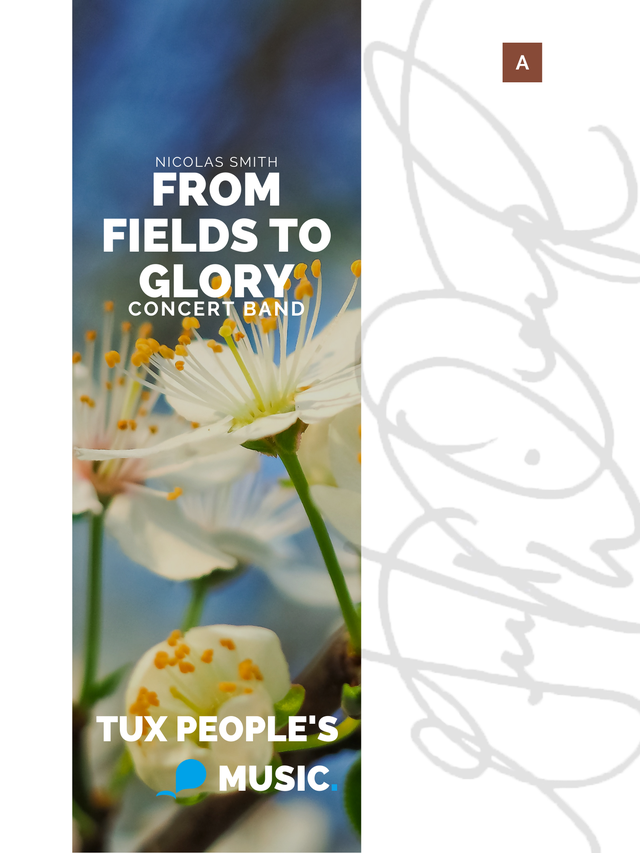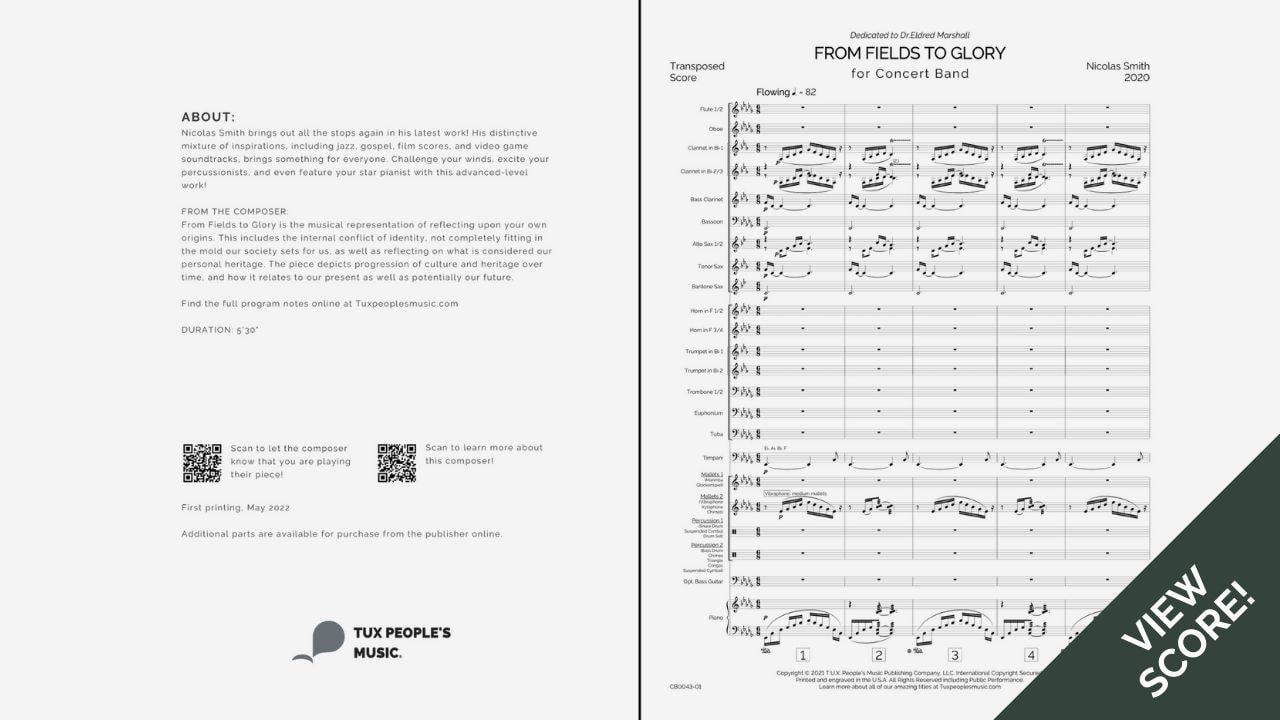- Concert Band
- >
- Advanced
- >
- From Fields to Glory
From Fields to Glory
SKU:
CB0043
$106.00
$106.00
Unavailable
per item
By Nicolas Smith
Nicolas Smith brings out all the stops again in his latest work! His distinctive mixture of inspirations, including jazz, gospel, film scores, and video game soundtracks, brings something for everyone. Challenge your winds, excite your percussionists, and even feature your star pianist with this advanced-level work!
Advanced
Looking to print this title instantly? Digital download options are available for this title though a number of our online retail partners! Browse them (here).
Prefer to purchase this title through one of your favorite online/local retailers?
-
AUDIO & SCORE
-
INSTRUMENTATION
-
FROM THE COMPOSER
<
>
Flute 1
Flute 2
Oboe
Clarinet in Bb 1
Clarinet in Bb 2
Clarinet in Bb 3
Bass Clarinet
Bassoon
Alto Sax 1
Alto Sax 2
Tenor Sax
Baritone Sax
Horn in F 1/2
Horn in F 3/4
Trumpet in Bb 1
Trumpet in Bb 2
Trombone 1
Trombone 2
Euphonium (T.C.)
Euphonium (B.C.)
Tuba
Timpani
Mallets 1:
Marimba
Glockenspiel
Mallets 2:
Vibraphone
Xylophone
Chimes
Percussion 1:
Snare Drum
Suspended Cymbal
Drum Set
Percussion 2:
Bass Drum
Chimes
Triangle
Congas
Suspended Cymbal
Opt. Bass Guitar
Piano
Flute 2
Oboe
Clarinet in Bb 1
Clarinet in Bb 2
Clarinet in Bb 3
Bass Clarinet
Bassoon
Alto Sax 1
Alto Sax 2
Tenor Sax
Baritone Sax
Horn in F 1/2
Horn in F 3/4
Trumpet in Bb 1
Trumpet in Bb 2
Trombone 1
Trombone 2
Euphonium (T.C.)
Euphonium (B.C.)
Tuba
Timpani
Mallets 1:
Marimba
Glockenspiel
Mallets 2:
Vibraphone
Xylophone
Chimes
Percussion 1:
Snare Drum
Suspended Cymbal
Drum Set
Percussion 2:
Bass Drum
Chimes
Triangle
Congas
Suspended Cymbal
Opt. Bass Guitar
Piano
From Fields to Glory is the musical representation of reflecting upon your own origins. This includes the internal conflict of identity, not completely fitting in the mold our society sets for us, as well as reflecting on what is considered our personal heritage. The piece depicts progression of culture and heritage over time, and how it relates to our present as well as potentially our future.
The beginning sections of the piece, mm.1-80, is a musical interpretation of Paul Laurence Dunbar’s poem We Wear the Mask, which has the overarching idea of pushing forward despite what the overall circumstance reveals. Section B to mm. 64 should be conducted and felt in 1, and mm. 65-79 should be in 3 to give a feeling of pushing forward. The triplet figure in the low brass and percussion (mm. 49-72) is best thought of as swung.
Section C is a call and response section between the clarinets, saxophones, and the chimes. The melody for this section comes from the Negro Spiritual Hold On. In the middle of this section, mm. 87-88, the horn cites a small segment from the Negro Spiritual Wade in the Water, which is a light foreshadow for what is to come in the next section.
Section D establishes an ostinato in the piano and marimba, which is another version of the Wade in the Water citation in the previous section. This section serves as a transition and setup for Section E, which represents reflection on our own Identity. Section E is a section of rapid-fire citations of various African American works throughout multiple genres. These works consist of; Going up Yonder, Afro-American Symphony Mov. I by William Grant Still, The Entertainer by Scott Joplin, Deep River, and Lift Every Voice and Sing.
Section F is a stylized aggressive version of the melody at Section B. This section can best be described as the grit and determination section, or like the training arc in a movie. This section is the embodiment of putting words to action. Instead of talking about moving forward and understanding yourself, this is the point where you come to terms with yourself and move on. mm.162-163 is the transition to the next section through time interpretation, 3/4 to 6/8. If you were to remove the percussion parts, you could argue that the Section F is in 3/4 or 6/8. The transition is aided by the drum set's premature change to 6/8 while everything else is technically still in 3/4.
Section G cites the melody from Section A but with more forward momentum, leading towards the climax of the piece at Section H. The climax is similar to Section C, but with a feeling of triumph and more energized woodwind percussion parts. At mm. 213, hold the fermata a little longer than you think is necessary.
The beginning sections of the piece, mm.1-80, is a musical interpretation of Paul Laurence Dunbar’s poem We Wear the Mask, which has the overarching idea of pushing forward despite what the overall circumstance reveals. Section B to mm. 64 should be conducted and felt in 1, and mm. 65-79 should be in 3 to give a feeling of pushing forward. The triplet figure in the low brass and percussion (mm. 49-72) is best thought of as swung.
Section C is a call and response section between the clarinets, saxophones, and the chimes. The melody for this section comes from the Negro Spiritual Hold On. In the middle of this section, mm. 87-88, the horn cites a small segment from the Negro Spiritual Wade in the Water, which is a light foreshadow for what is to come in the next section.
Section D establishes an ostinato in the piano and marimba, which is another version of the Wade in the Water citation in the previous section. This section serves as a transition and setup for Section E, which represents reflection on our own Identity. Section E is a section of rapid-fire citations of various African American works throughout multiple genres. These works consist of; Going up Yonder, Afro-American Symphony Mov. I by William Grant Still, The Entertainer by Scott Joplin, Deep River, and Lift Every Voice and Sing.
Section F is a stylized aggressive version of the melody at Section B. This section can best be described as the grit and determination section, or like the training arc in a movie. This section is the embodiment of putting words to action. Instead of talking about moving forward and understanding yourself, this is the point where you come to terms with yourself and move on. mm.162-163 is the transition to the next section through time interpretation, 3/4 to 6/8. If you were to remove the percussion parts, you could argue that the Section F is in 3/4 or 6/8. The transition is aided by the drum set's premature change to 6/8 while everything else is technically still in 3/4.
Section G cites the melody from Section A but with more forward momentum, leading towards the climax of the piece at Section H. The climax is similar to Section C, but with a feeling of triumph and more energized woodwind percussion parts. At mm. 213, hold the fermata a little longer than you think is necessary.



